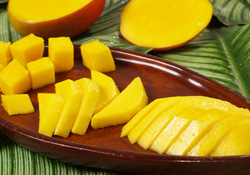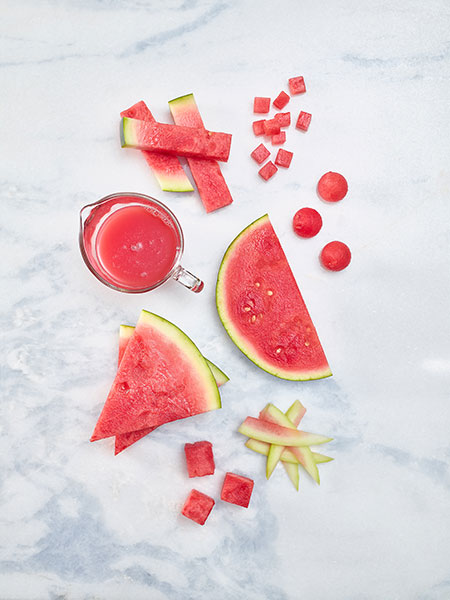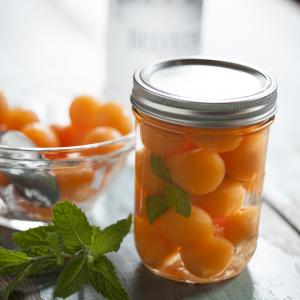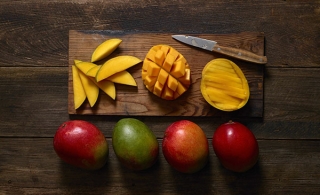Recall your first knife skills class. Or, think about the knife skills class or technique you teach students. Do you ask your students to think like a butcher? True, professional butchering requires advanced knife skills, knowledge of how meat and bone separate and an ability to see value-added cuts hiding in a hunk of flesh. But in today’s world, chefs need to understand waste reduction, maximum yield and finding valued-added products. These knife skills go beyond simple vegetable and fruit slicing and dicing.
Let’s look at mangos, watermelon and cantaloupes but see them through a butcher’s eyes. How can we efficiently deconstruct the fruit to find basic slices while also looking for cuts consumers may perceive as valuable, such as a mango julienne, cantaloupe ball or a watermelon steak fry. Then, let’s look at the left-over carcass and not waste a scrap.
Chef Jason Hernandez of Blade & Tine Culinary Consulting offers these tips and reminders before beginning the carving process.
- Remember to let the blade do the job when cutting produce.
- Clean, sharp knives are safer and make cleaner cuts.
- An eight- to 10-inch chef’s knife has some flex to it for cutting larger fruits and more easily cuts around curves.
- Cutting gloves prevent cuts and help you concentrate better on the job at hand.
Now, let’s get down to the business of cutting. First up -
 Mango fabrication
Mango fabrication
Chef Hernandez suggests thinking about the mango seed as the bone a butcher would cut around. After removing the peel, he offers:
- Cut the cheeks away from the flat side of the seed, and then—thinking like a butcher—continue by trimming the fruit that clings to the seed. The trim can be used for applications that do not require a specific cut or puree.
- Don’t toss the mango “bone” but use it as an “infuser” for water and spirits on beverage menus and as a way to add more flavor to sauces like mole. Instructors can also grill the seeds to add smokey, caramelized mango flavor to sauces.
- The mango cheek provides a variety of sizes and cut shapes: dice, slice, wedge, or value-added julienne. Chef Hernandez said that quarter- or half-inch dice pieces work best for most applications like salsas and toppings for salads and tacos. The cheek can also be cut lengthwise and crosswise, appropriate for grilling and charring. He said the larger pieces have more surface area to caramelize and will also hold their shape when cooked.
- Chef Hernandez suggests creating a mango “hedgehog” for culinary display. First, cut the cheeks away from the mango without peeling. Then carefully cut the flesh into squares without cutting through the peel and invert the cheek and peel to create a hedgehog form. Some people also use this method to cut mango cubes for recipes where the integrity is not as important.
- Click here for an infographic on mango fabrication.
 Watermelon deconstruction
Watermelon deconstruction
Watermelon is a completely usable fruit with no waste, even the peel can be used for its color and design as a garnish on a plate or pickled for a sweet and sour kick in applications. When cutting a watermelon, consider removing the peel as a butcher would remove a fat cap.
- First, cut off both watermelon ends providing access to the peel and rind.
- Tip the watermelon upright and with an angled knife begin where the white rind meets the red flesh cut off the rind following the fruit’s curve.
- Tip the watermelon on its side and cut into disks. The disk’s width is dependent upon the width of the required cut.
- Chef Hernandez says that watermelon flesh is like a large cut of meat that can be broken down into many shapes and sizes, such as cubes, wedges, squares, and balls with any trim used for pureed juice or sauce. He particularly likes value-added steak cuts because its a thicker cut that can be seasoned and grilled.
- Pickling rind and julienne cuts for slaw are popular uses for what can be considered “scrap.” Also, drying and seasoning watermelon seeds can add crunch to applications from salads to trail mixes.
- Chef Hernandez also suggests a sweet application beyond the flesh: candy the rind. Candied rind can top desserts, dip into chocolate and or become a drink garnish.
- Click here for an infographic on watermelon deconstruction.
 Breaking down cantaloupe
Breaking down cantaloupe
Similar to watermelon, cantaloupe is a fruit that can be used from seeds to flesh. Also, when broken down, cantaloupe’s large flesh pieces can be sliced into various cuts including cubes, wedges, squares and value-added melon balls. Thinking like a butcher, removing cantaloupe rind is similar to removing skin from a fish.
- Cut the cantaloupe in half and scoop out the seeds, reserving them for later use.
- For melon balls, push a melon scooper into the flesh half and turn 360 degrees. Take out the scooper and place the melon balls in a dish for use in salads, appetizers, cocktails or to create melon-infused liquor.
- For other shapes such as a dice, cut the cantaloupe half in half again for quarters. Continuing quartering until the correct dice width is achieved.
- Next, make horizontal cuts from one side of the melon quarter to the other, cutting through the flesh but not through the rind. Thinking as a butcher would skin a fish, use your hand to flatten the quarter and run your knife under the flesh close to the rind from one end to the other. Invert the quarter and the cubes will fall out.
- For cantaloupe slabs, perfect for cookie-cutter shapes, slice the end off the cantaloupe and turn the fruit upright. Beginning on one side, cut the melon into slabs until you hit the seeds. Rotate the melon a quarter turn, and do the same for the next side. Continue until all four sides are complete. Take a flat slab on a table and press a cookie cutter into flesh and pop out a special melon shape perfect for appetizer, fruit skewer or drink garnish.
- Leaving no waste behind, take the cantaloupe seeds and wash and dry them. Season with a sweet or savory spice blend and roast. Include the seeds in everything from salads to desserts.
Chef Hernandez suggests for advance prep work that cut fruit hold well when refrigerated in advance of a shift or event. He also reminded that all fresh produce items should be handled and prepped following proper food safety protocols.
